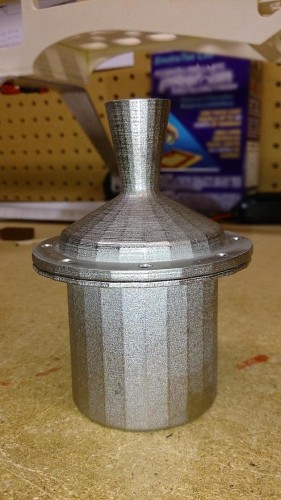
Alex Kuehn of Xair Robotics recently shared his new working prototype for a solid fuel rocket engine, printed at Shapeways. Shapeways is no stranger to 3D printing for Space exploration but this engine is a novel invention. Alex describes it to be, “to the best of our knowledge this is the FIRST EVER in the history of mankind, 3D Printed Reusable Solid Fuel Rocket Engine and the components were printed by Shapeways out of the nickel plated stainless steel material.”
Alex is a young engineer and founder of Xair. He currently is also cutting his teeth designing production tooling for jet aircraft design professionally at Cirrus Aircraft. Xair is a passion project with lofty goals: “The underlying dream here is advanced vehicles for the everyday person at a price they could afford. ”
Continuing, he notes “It’s taken 9 months of hard work, countless iterations, and many prototypes to get to this point and it’s really very exciting, however there still is a great deal of work to do before we will be able to bring our hobby motors to the public in the form of a refined product. ”

“The XR58 (the engine in question) was first tested on October 31st of this year and has since been tested a total of five times proving its validity as a reusable design. The motor is as simple as pouring the fuel in and bolting the nozzle on and has an operational cost 97% cheaper than a disposable motor with the same quantity of propellant. We are now working adamantly on a way to adapt what we have learned with this program to build an engine that can be sold to the hobby and enthusiast market. ”
“We knew nothing about rocket propulsion when we built our first little engine and here we are nine months later with a fully reusable 3D printed rocket engine. We hope to scale the knowledge we’ve gained through this program to build larger motors, with our next batch of motors hopefully being large enough to fly a small manned vehicle to prove the safety and reliability of our engines, with the ultimate goal being to produce a manned suborbital launch vehicle akin to the availability, presence, accessibility, and affordability that can be found in home-built aircraft today. ”
“For myself and Paul Adelgren [friend and partner in engineering duties for XAIR] we’ve both always wanted to go to space and that is where our rocket motor program sprouted from. We knew we would never get to go if we had to pay hundreds of thousands of dollars to do it and besides, where was the fun in just going for a ride on someone else’s rocket as a tourist? We dreamed (and still dream) of going to space on our own personal space vehicles and that is where this is all headed should it be in the cards.”


